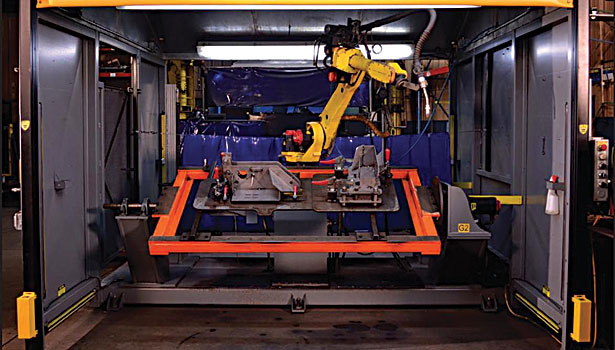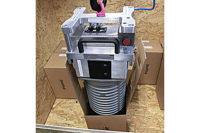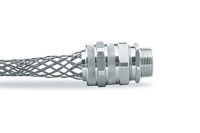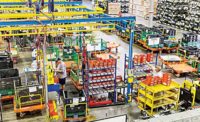Since the start of the Great Recession in 2008, many Tier 1 suppliers have either closed or downsized. F&P America Manufacturing Inc., in contrast, has continued to operate at maximum capacity. The keys to the company’s success are JIT manufacturing and safe robotic welding.
F&P opened in Troy, OH, in 1994 as a 100,000-square-foot welding shop with 80 employees. Today, the company operates a 300,000-square-foot facility where 500 employees stamp, weld, assemble and paint 1,800 to 2,000 assemblies per day, six days a week.
F&P supplies parts to Mitsubishi, General Motors and Honda. Its largest customer is Honda, which also follows JIT manufacturing. Parts are shipped to Honda four hours before they are needed for production. F&P maintains a three-day inventory of parts and a one-day inventory of finished goods.
More than 300 robotic welders are required for the plant’s high productivity. But, worker safety is F&P’s main priority, as it has achieved 1 million hours without a lost time accident on several occasions.
To protect workers, the company places physical barriers between them and the robots, and uses Guardian automated light curtains in 12 robotic weld cells. Frommelt Safety Products makes the curtains, which shield workers from welding arc flash and splatter, and prevent their entry into the welding cell.
The light curtains include several dual-units and two 13-foot-wide units. All models feature curtains made of fire-resistant, 50-ounce black vinyl.
With dual-units, the operator loads a part on one side of the cell, and the robot welds on the other side. A barrier is closed in front of the robot, but a second barrier on the other side of the cell is open so workers can load parts.
When welding is completed, the second barrier closes and the robot rotates to begin welding on the other side of the cell. Simultaneously, the other barrier opens so workers can unload parts.
“This system is ideal,” says Dave Parmenter, assistant manager of the Technical Group at F&P America Manufacturing Inc. “The associate doesn’t wait on the robot, and the robot doesn’t wait on the associate."
Each 13-foot-wide unit is used in a cell featuring two workers. The unit remains in the down position until the robot has completed welding. It then opens so one worker unloads finished parts. The unit’s 9-foot table is rotated, and another employee loads new parts.
A poke-yoke system, featuring an electronic sensor, ensures that all parts are in place prior to welding. This
attention to detail enabled F&P to earn the Honda Quality Performance Award from 2003 to 2005, and the American Honda Supplier Performance Award from 2010 to 2012.
Another reason F&P likes the Guardian units is their footprint flexibility. When using small welding fixtures, the company can position the light curtains upright around the workcell to reduce the required fall zone of the robotic welder. When physical barriers are not in place, light curtains are positioned horizontally to detect people in the fall zone.
For more information on safety barriers, call 800-553-5560 or visit




